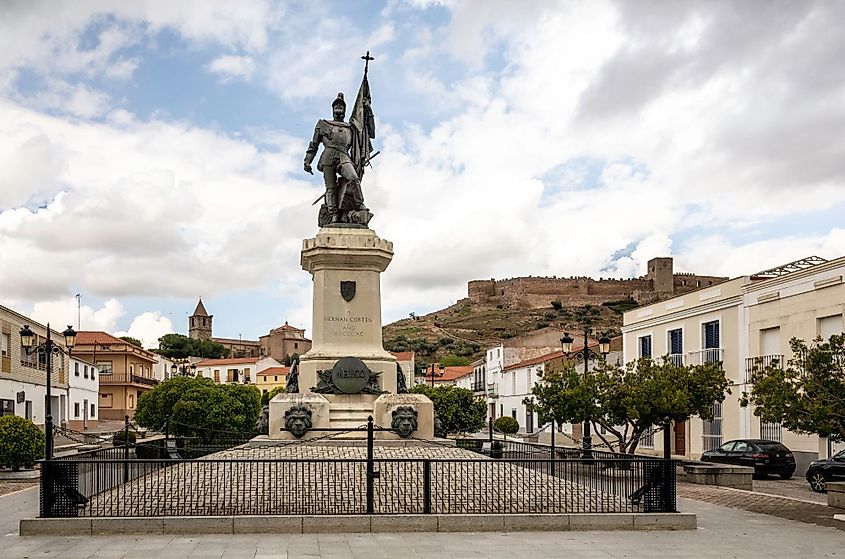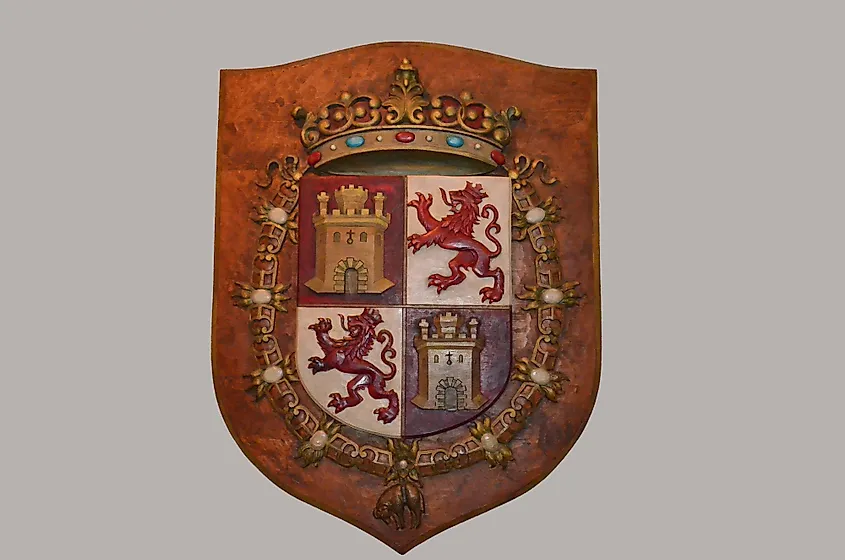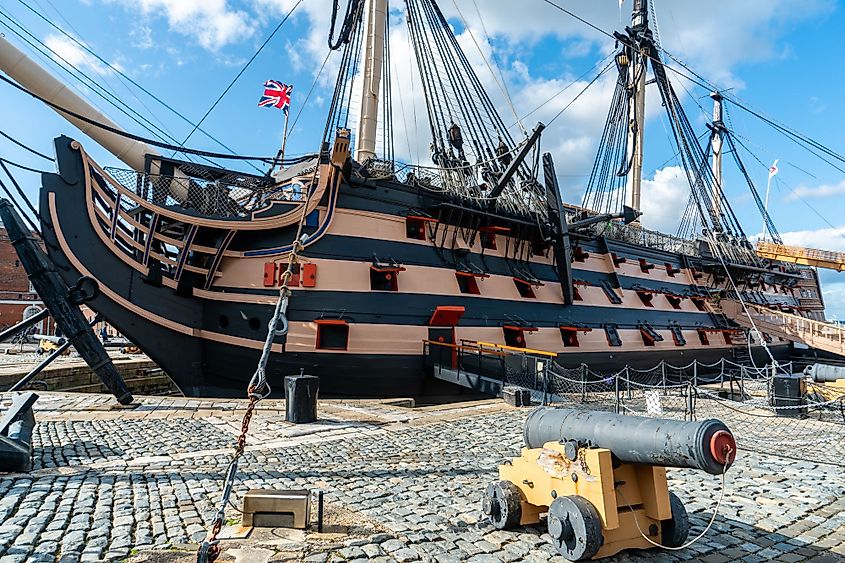

The story of the Spanish Empire begins in the early 15th century. This was the last century of the Reconquista (Re-conquest), the centuries-old campaign by Christian forces to retake the Iberian Peninsula from the Muslim Arabs, who had conquered it in the 8th century. By the early 15th century, Muslim control of the Iberian Peninsula had been reduced to one kingdom on the southeast coast of the Iberian Peninsula known as Granada. The rest of the peninsula was controlled by four Christian kingdoms: Portugal, Navarre, Castile, and Aragon. In 1469, Ferdinand of Aragon and Isabella of Castile married. Ten years later, with both of them on the thrones of their respective countries, the crowns were united and the Kingdom of Spain was born.
Source: The World Atlas
By the time Spain became a united kingdom, it already controlled territory outside of the Iberian Peninsula, including the Canary Islands, Sardinia, and Sicily. In 1492, the Spaniards conquered Granada, thus destroying the last remaining Muslim outpost on the Iberian Peninsula. Coincidentally, this was the same year that Christopher Columbus set sail on his historic voyage to the so-called New World. His arrival in the Caribbean islands marked the beginning of Spanish colonization.
During the first half of the 16th century, the Spanish Empire expanded rapidly, seizing the Kingdom of Navarre, as well as lands in Western and Central Europe. At the same time, Spain’s colonial holdings in the Caribbean were growing. By 1521, Spain had laid claimed to Cuba, Jamaica, Puerto Rico, Panama, and Hispaniola, the island on which the present-day countries of Haiti and the Dominican Republic are situated. It was in 1521 that the Spanish Empire entered what is called “The Golden Age of Spain”.
Source: The World Atlas

When King Charles I ascended the Spanish throne, he was able to rule about a quarter of Europe, not by conquest, but rather by inheritance because of the marital alliances established by the Reyes Catolicos (Catholic Kings) prior to his rule. He inherited Spain’s colonial possessions as well as the crowns of the Holy Roman Empire, the Low Countries (present-day Belgium, the Netherlands, and Luxembourg), and Franche-Comte (region of present-day northeastern France). Thus, Charles I became the most powerful man in Europe. In fact, his empire would not be rivalled until the Napoleonic Era.
 Statue of Spanish Conquistador Hernan Cortes in Medellin, Spain, who led an expedition that led to the fall of the Aztec Empire.
Statue of Spanish Conquistador Hernan Cortes in Medellin, Spain, who led an expedition that led to the fall of the Aztec Empire.
Meanwhile, Spain’s conquest of the New World was moving at a rapid pace. Spanish Conquistadors laid waste to the Aztec Empire in present-day Mexico, culminating in the birth of the Spanish colony of New Spain in 1521. Spain’s conquest of the Inca Empire in South America led to the establishment of the Viceroy of Peru. Following the conquest of the two aforementioned empires, rumors of the existence of cities of gold in both North and South America pushed the Spaniards into mounting further expeditions into territory in the Americas not yet under their control. They were disappointed, however, as they did not find the rumored cities of gold, and what wealth they did find was much less than they had hoped for. In fact, the resources from the Americas would not become a significant part of the Spain’s revenues until the late 16th century, when silver from the Americas accounted for one-fifth of the country’s total budget.
 Coat of Arms of the Spanish Empire. Editorial credit: andysartworks / Shutterstock.com
Coat of Arms of the Spanish Empire. Editorial credit: andysartworks / Shutterstock.com
The mid-to-late 16th century was when the Spanish Empire was at its peak. By this time, the empire controlled large parts of North and South America, and the Caribbean. It also had control of the Philippines and some other Pacific islands, not to mention its European possessions. King Philip II (1556-1598) would be the presiding ruler during the zenith of the Spanish Empire, but it was also him who presided over some significant defeats. Quelling rebellion in the Spanish Netherlands and growing piracy in the Caribbean severely damaged Spain’s finances. In addition, the empire suffered a resounding defeat in 1588, when the Spanish Armada was destroyed by the English Navy in an attempt to invade England. When King Philip II died, he left Spain bankrupt. Nevertheless, the Spanish Empire continued to endure. In fact, the empire gained even more territory after its union with the crown of Portugal in 1581, thereby gaining territory on the east coast of South America, as well as smaller territories in Africa and Asia. But by the early-to-mid 17th century, the Spanish Empire began a slow decline.
Source: The World Atlas
Throughout history, several empires have existed that were renowned for their tremendous military power, influence and territorial reach. One of these was the Spanish Empire. Spanning Europe, the Americas and parts of Asia, the Spanish Empire quickly grew to become one of the most powerful forces on the planet.
Given its tremendous growth, vast resources and territorial gains, an obvious question arises: Why did the Spanish Empire fall? This article traces the rise and development of Spain as a major European power and examines the causes of its overall decline. What factors led to Spain's waning influence on the world stage? Could these problems have been avoided?
The rise of a newly unified Spain in the 16th and 17th centuries is one of the surprise stories of world history. As late as the 1460s, Spain was still fragmented. The Crown of Castile and Aragon were separate entities ruled by different monarchs. Even worse than this, Castile was in turmoil as King Henry and his half-siblings, Alfonso and Isabella, fought over the crown. Yet within a decade, these troubles were gone—thanks, in part, to the marriage of Isabella of Castile and Ferdinand of Aragon. For the first time in years, the two crowns were on their way to being united by their monarchs.
In the decades that followed, Castile finished the Reconquista by subduing Granada. At the same time, the joint forces of Castille and Aragon conquered the Kingdom of Naples in the late 15th and early 16th centuries. Once Charles V succeeded his grandfather, Ferdinand of Aragon, the two crowns also added the Habsburg domains. With these new kingdoms under their control, the Catholic Monarchs united.
From the 1640s onward, Spain faced a number of challenges. Rebellions against Spanish rule surfaced in Portugal, southern Italy, and Catalonia. The union with Portugal ended, though the Spaniards did manage to hang on to southern Italy and Catalonia. Spain did, however, lose territory in Europe over the course of the 17th century. In addition, the country was beset by economic ruin and a series of plagues that killed at least 1.25 million people. During this tumultuous time, the leadership of the Spanish Empire was inept and incompetent, leaving the realm’s defenses weak and antiquated. By the early 18th century, Spain had lost all its territories in Europe aside from the Kingdom of Spain itself. The Spanish Empire did recover somewhat in the rest of the 18th century. Trade in the colonies boomed, and there was renewed growth in precious metals mining in the Americas. Spain began to modernize its institutions and economy. The 18th century was also relatively peaceful compared to other centuries. The empire even managed to conquer some new territory overseas. But Spain was still not the first rate power it once was. Indeed, it was still quite backward compared to its rivals.
 HMS Victory - Admiral Horatio Nelson's flagship at the Battle of Trafalgar in 1805 at Portsmouth Historic Dockyard, United Kingdom.
HMS Victory - Admiral Horatio Nelson's flagship at the Battle of Trafalgar in 1805 at Portsmouth Historic Dockyard, United Kingdom.
The real death knell of the Spanish Empire would come in the 19th century. It began with Spain’s loss of the Louisiana Territory in 1800 to the French. Just five years later, the historic naval Battle of Trafalgar took place, in which British forces defeated a French-Spanish fleet. This battle marked the end of Spain’s great naval power. By 1824, Spain had lost all of its territory on the North and South American mainland, as its colonies became independent countries. What remained of the Spanish Empire were small amounts of territory in the Caribbean, Africa, and Asia. In the Spanish-American War of 1898, Spain lost control of its Caribbean and Asian colonies, including Cuba, Puerto Rico, and the Philippines. Finally, in the mid-20th century, Spain relinquished control of the Western Sahara and Equatorial Guinea. Today, Spain has no colonial possessions aside from small enclaves on and off the Mediterranean coast of the Kingdom of Morocco.
Source: The World Atlas
During the early 19th century, however, there was a conspicuous exception to the trend of colonial growth, and that was the decline of the Portuguese and Spanish empires in the Western Hemisphere. The occasion for the decolonization was provided by the Napoleonic Wars. The French occupation of the Iberian Peninsula in 1807, combined with the ensuing years of intense warfare until 1814 on that peninsula between the British and French and their respective allies, effectively isolated the colonies from their mother countries. During this isolation the long-smouldering discontents in the colonies erupted in influential nationalist movements, revolutions of independence, and civil wars. The stricken mother countries could hardly interfere with events on the South American continent, nor did they have the resources, even after the Peninsular War was over, to bring enough soldiers and armaments across the Atlantic to suppress the independence forces.
Great Britain could have intervened on behalf of Spain and Portugal, but it declined. British commerce with South America had blossomed during the Napoleonic Wars. New vistas of potentially profitable opportunities opened up in those years, in contrast with preceding decades when British penetration of Spanish colonial markets consisted largely of smuggling to get past Spain’s mercantile restrictions. The British therefore now favoured independence for these colonies and had little interest in helping to reimpose colonial rule, with its accompanying limitations on British trade and investment. Support for colonial independence by the British came in several ways: merchants and financiers provided loans and supplies needed by insurrectionary governments; the Royal Navy protected the shipment of those supplies and the returning specie; and the British government made it clear to other nations that it considered South American countries independent. The British forthright position on independence, as well as the availability of the Royal Navy to support this policy, gave substance to the U.S. Monroe Doctrine (1823), which the United States had insufficient strength at that time to really enforce.
After some 15 years of uprisings and wars, Spain by 1825 no longer had any colonies in South America itself, retaining only the islands of Cuba and Puerto Rico. During the same period Brazil achieved its independence from Portugal. The advantages to the British economy made possible by the consequent opening up of the Latin-American ports were eagerly pursued, facilitated by commercial treaties signed with these young nations. The reluctance of France to recognize their new status delayed French penetration of their markets and gave an advantage to the British. In one liberated area after another, brokers and commercial agents arrived from England to ferret out business opportunities. Soon the continent was flooded with British goods, often competing with much weaker native industries. Actually, Latin America provided the largest single export market for British cotton textiles in the first half of the 19th century.
Despite the absence of formal empire, the British were able to attain economic preeminence in South America. Spanish and Portuguese colonialism had left a heritage of disunity and conflict within regions of new nations and between nations, along with conditions that led to unstable alliances of ruling elite groups. While this combination of weaknesses militated against successful self-development, it was fertile ground for energetic foreign entrepreneurs, especially those who had technically advanced manufacturing capacities, capital resources, international money markets, insurance and shipping facilities, plus supportive foreign policies. The early orgy of speculative loans and investments soon ended. But before long, British economic penetration entered into more lasting and self-perpetuating activities, such as promoting Latin-American exports, providing railroad equipment, constructing public works, and supplying banking networks. Thus, while the collapse of the Spanish and Portuguese empires led to the decline of colonialism in the Western Hemisphere, it also paved the way for a significant expansion of Britain’s informal empire of trade, investment, and finance during the 19th century.
European influence around the globe increased with each new wave of emigration from Europe. Tides of settlers brought with them the Old World culture and, often, useful agricultural and industrial skills. An estimated 55,000,000 Europeans left their native lands in the 100 years after 1820, the product chiefly of two forces: (1) the push to emigrate as a result of difficulties arising from economic dislocations at home and (2) the pull of land, jobs, and recruitment activities of passenger shipping lines and agents of labour-hungry entrepreneurs in the New World. Other factors were also clearly at work, such as the search for religious freedom, escape from tyrannical governments, avoidance of military conscription, and the desire for greater upward social and economic mobility. Such motives had existed throughout the centuries, however, and they are insufficient to explain the massive population movements that characterized the 19th century. Unemployment induced by rapid technological changes in agriculture and industry was an important incentive for English emigration in the mid-1800s. The surge of German emigration at roughly the same time is largely attributable to an agricultural revolution in Germany, which nearly ruined many farmers on small holdings in southwestern Germany. Under English rule, the Irish were prevented from industrial development and were directed to an economy based on export of cereals grown on small holdings. A potato blight, followed by famine and eviction of farm tenants by landlords, gave large numbers of Irish no alternative other than emigration or starvation. These three nationalities—English, German, and Irish—composed the largest group of migrants in the 1850s. In later years Italians and Slavs contributed substantially to the population spillover. The emigrants spread throughout the world, but the bulk of the population transfer went to the Americas, Siberia, and Australasia. The population outflow, greatly facilitated by European supremacy outside Europe, helped ease the social pressures and probably abated the dangers of social upheaval in Europe itself.
The outward movement of European peoples in any substantial numbers naturally was tied in with conquest and, to a greater or lesser degree, with the displacement of indigenous populations. In the United States, where by far the largest number of European emigrants went, acquisition of space for development by white immigrants entailed activity on two fronts: competition with rival European nations and disposition of the Indians. During a large part of the 19th century, the United States remained alert to the danger of encirclement by Europeans, but in addition the search for more fertile land, pursuit of the fur trade, and desire for ports to serve commerce in the Atlantic and Pacific oceans nourished the drive to penetrate the American continent. The most pressing points of tension with European nations were eliminated during the first half of the century: purchase of the Louisiana Territory from France in 1803 gave the United States control over the heartland of the continent; settlement of the War of 1812 ended British claims south of the 49th parallel up to the Rocky Mountains; Spain’s cession of the Floridas in 1819 rounded out the Atlantic coastal frontier; and Russia’s (1824) and Great Britain’s (1846) relinquishment of claims to the Oregon territory gave the United States its window on the Pacific. The expansion of the United States, however, was not confined to liquidating rival claims of overseas empires; it also involved taking territory from neighbouring Mexico. Settlers from the United States wrested Texas from Mexico (1836), and war against Mexico (1846–48) led to the U.S. annexation of the southwestern region between New Mexico and Utah to the Pacific Ocean.
Diplomatic and military victories over the European nations and Mexico were but one precondition for the transcontinental expansion of the United States. In addition, the Indian tribes sooner or later had to be rooted out to clear the new territory. At times, treaties were arranged with Indian tribes, by which vast areas were opened up for white settlement. But even where peaceful agreements had been reached, the persistent pressure of the search for land and commerce created recurrent wars with Indian tribes that were seeking to retain their homes and their land. Room for the new settlers was obtained by forced removal of natives to as yet non-white-settled land—a process that was repeated as white settlers occupied ever more territory. Massacres during wars, susceptibility to infectious European diseases, and hardships endured during forced migrations all contributed to the decline in the Indian population and the weakening of its resistance. Nevertheless, Indian wars occupied the U.S. Army’s attention during most of the 19th century, ending with the eventual isolation of the surviving Indians on reservations set aside by the U.S. government.
Source: https://www.britannica.com/topic/Western-colonialism/Decline-of-the-Spanish-and-Portuguese-empires

The Spanish-American War was an 1898 conflict between the United States and Spain that ended Spanish colonial rule in the Americas and resulted in U.S. acquisition of territories in the western Pacific and Latin America. To read more on the History.com site, click HERE.